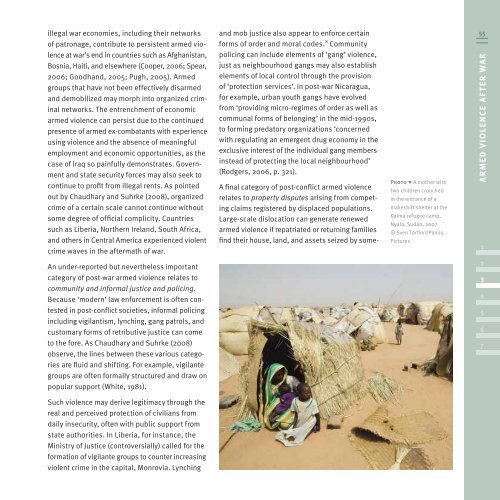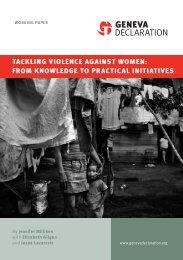Global Burden of Armed Violence - The Geneva Declaration on ...
Global Burden of Armed Violence - The Geneva Declaration on ...
Global Burden of Armed Violence - The Geneva Declaration on ...
You also want an ePaper? Increase the reach of your titles
YUMPU automatically turns print PDFs into web optimized ePapers that Google loves.
illegal war ec<strong>on</strong>omies, including their networks<br />
<str<strong>on</strong>g>of</str<strong>on</strong>g> patr<strong>on</strong>age, c<strong>on</strong>tribute to persistent armed violence<br />
at war’s end in countries such as Afghanistan,<br />
Bosnia, Haiti, and elsewhere (Cooper, 2006; Spear,<br />
2006; Goodhand, 2005; Pugh, 2005). <str<strong>on</strong>g>Armed</str<strong>on</strong>g><br />
groups that have not been effectively disarmed<br />
and demobilized may morph into organized criminal<br />
networks. <str<strong>on</strong>g>The</str<strong>on</strong>g> entrenchment <str<strong>on</strong>g>of</str<strong>on</strong>g> ec<strong>on</strong>omic<br />
armed violence can persist due to the c<strong>on</strong>tinued<br />
presence <str<strong>on</strong>g>of</str<strong>on</strong>g> armed ex-combatants with experience<br />
using violence and the absence <str<strong>on</strong>g>of</str<strong>on</strong>g> meaningful<br />
employment and ec<strong>on</strong>omic opportunities, as the<br />
case <str<strong>on</strong>g>of</str<strong>on</strong>g> Iraq so painfully dem<strong>on</strong>strates. Government<br />
and state security forces may also seek to<br />
c<strong>on</strong>tinue to pr<str<strong>on</strong>g>of</str<strong>on</strong>g>it from illegal rents. As pointed<br />
out by Chaudhary and Suhrke (2008), organized<br />
crime <str<strong>on</strong>g>of</str<strong>on</strong>g> a certain scale cannot c<strong>on</strong>tinue without<br />
some degree <str<strong>on</strong>g>of</str<strong>on</strong>g> <str<strong>on</strong>g>of</str<strong>on</strong>g>ficial complicity. Countries<br />
such as Liberia, Northern Ireland, South Africa,<br />
and others in Central America experienced violent<br />
crime waves in the aftermath <str<strong>on</strong>g>of</str<strong>on</strong>g> war.<br />
An under-reported but nevertheless important<br />
category <str<strong>on</strong>g>of</str<strong>on</strong>g> post-war armed violence relates to<br />
community and informal justice and policing.<br />
Because ‘modern’ law enforcement is <str<strong>on</strong>g>of</str<strong>on</strong>g>ten c<strong>on</strong>tested<br />
in post-c<strong>on</strong>flict societies, informal policing<br />
including vigilantism, lynching, gang patrols, and<br />
customary forms <str<strong>on</strong>g>of</str<strong>on</strong>g> retributive justice can come<br />
to the fore. As Chaudhary and Suhrke (2008)<br />
observe, the lines between these various categories<br />
are fluid and shifting. For example, vigilante<br />
groups are <str<strong>on</strong>g>of</str<strong>on</strong>g>ten formally structured and draw <strong>on</strong><br />
popular support (White, 1981).<br />
Such violence may derive legitimacy through the<br />
real and perceived protecti<strong>on</strong> <str<strong>on</strong>g>of</str<strong>on</strong>g> civilians from<br />
daily insecurity, <str<strong>on</strong>g>of</str<strong>on</strong>g>ten with public support from<br />
state authorities. In Liberia, for instance, the<br />
Ministry <str<strong>on</strong>g>of</str<strong>on</strong>g> Justice (c<strong>on</strong>troversially) called for the<br />
formati<strong>on</strong> <str<strong>on</strong>g>of</str<strong>on</strong>g> vigilante groups to counter increasing<br />
violent crime in the capital, M<strong>on</strong>rovia. Lynching<br />
and mob justice also appear to enforce certain<br />
forms <str<strong>on</strong>g>of</str<strong>on</strong>g> order and moral codes. 8 Community<br />
policing can include elements <str<strong>on</strong>g>of</str<strong>on</strong>g> ‘gang’ violence,<br />
just as neighbourhood gangs may also establish<br />
elements <str<strong>on</strong>g>of</str<strong>on</strong>g> local c<strong>on</strong>trol through the provisi<strong>on</strong><br />
<str<strong>on</strong>g>of</str<strong>on</strong>g> ‘protecti<strong>on</strong> services’. In post-war Nicaragua,<br />
for example, urban youth gangs have evolved<br />
from ‘providing micro-regimes <str<strong>on</strong>g>of</str<strong>on</strong>g> order as well as<br />
communal forms <str<strong>on</strong>g>of</str<strong>on</strong>g> bel<strong>on</strong>ging’ in the mid-1990s,<br />
to forming predatory organizati<strong>on</strong>s ‘c<strong>on</strong>cerned<br />
with regulating an emergent drug ec<strong>on</strong>omy in the<br />
exclusive interest <str<strong>on</strong>g>of</str<strong>on</strong>g> the individual gang members<br />
instead <str<strong>on</strong>g>of</str<strong>on</strong>g> protecting the local neighbourhood’<br />
(Rodgers, 2006, p. 321).<br />
A final category <str<strong>on</strong>g>of</str<strong>on</strong>g> post-c<strong>on</strong>flict armed violence<br />
relates to property disputes arising from competing<br />
claims registered by displaced populati<strong>on</strong>s.<br />
Large-scale dislocati<strong>on</strong> can generate renewed<br />
armed violence if repatriated or returning families<br />
find their house, land, and assets seized by some-<br />
Photo " A mother with<br />
two children crouched<br />
in the entrance <str<strong>on</strong>g>of</str<strong>on</strong>g> a<br />
makeshift shelter at the<br />
Kalma refugee camp,<br />
Nyala, Sudan, 2007.<br />
© Sven Torfinn/Panos<br />
Pictures<br />
55<br />
A R M E D V I O L E N C E A F T E R WA R<br />
1<br />
2<br />
3<br />
4<br />
5<br />
6<br />
7









